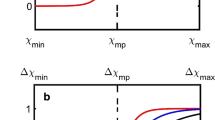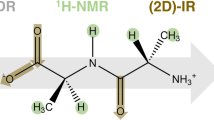Abstract
IN an earlier communication1 we reported that mixtures of N-methylacetamide (NMA) or N,N-dimethylacetamide (DMA) with strong aqueous lithium bromide show viscosities much higher than those calculated on the assumption of ideal mixing. This was termed ‘relative viscosity’, which is different from the usual use of this term. It was proposed that the high viscosity is caused by aggregation arising from carbonyl–lithium (I) and carbonyl–water–lithium (II) associations.  Dots indicate hydrogen bonds, and dashes ion-dipole interactions. These associations were also considered to occur in protein denaturation. We now report evidence for the existence of both types of association, as well as peptide-anion associations.
Dots indicate hydrogen bonds, and dashes ion-dipole interactions. These associations were also considered to occur in protein denaturation. We now report evidence for the existence of both types of association, as well as peptide-anion associations.
Similar content being viewed by others
References
Bello, J., and Bello, H. R., Nature, 190, 440 (1961).
Bufalini, J., and Stern, K. H., J. Amer. Chem. Soc., 83, 4362 (1961).
Kumler, W. D., J. Amer. Chem. Soc., 83, 4983 (1961).
Bello, J., Riese, H., and Vinograd, J. R., J. Phys. Chem., 60, 1299 (1956).
Author information
Authors and Affiliations
Rights and permissions
About this article
Cite this article
BELLO, J., BELLO, H. Evidence from Model Peptides relating to the Denaturation of Proteins by Lithium Salts. Nature 194, 681–682 (1962). https://doi.org/10.1038/194681b0
Issue Date:
DOI: https://doi.org/10.1038/194681b0
- Springer Nature Limited
This article is cited by
-
Beyond Hofmeister
Nature Chemistry (2014)
-
Die Koordination von Ni2+ und Co2+ in L�sung von N,N-Dimethylacetamid
Monatshefte f�r Chemie (1973)
-
Complex Formation of Monomeric Amides with Lithium Perchlorate
Nature (1962)





